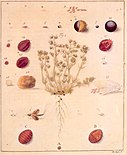Portal:Poland/Selected article/8
Ancient Slavs developed a method of obtaining crimson dye from Polish cochineal, a scale insect, whose larvae are dark red sessile parasites living on the roots of various herbs growing on the sandy soils of Central Europe. Despite the labor-intensive process of harvesting the larvae and a relatively modest yield, the dye continued to be a highly sought-after commodity and a popular alternative to kermes throughout the Middle Ages until it was superseded by Mexican cochineal in the 16th century. The insects were killed with boiling water or vinegar and dried in the sun or in an oven, ground, and dissolved in sourdough or in light rye beer called kvass in order to remove fat. The extract could then be used for dyeing silk, wool, cotton or linen. In the 15th–16th centuries, along with grain, timber and salt, it was one of Poland's and Lithuania's chief exports, mainly to southern Germany and northern Italy as well as to France, England, the Ottoman Empire and Armenia. Its historical importance is still reflected in most modern Slavic languages where the words for the color red and for June – the month of Polish cochineal harvest – both derive from the Proto-Slavic *čьrvь, meaning "a worm" or "larva". (Full article...)

